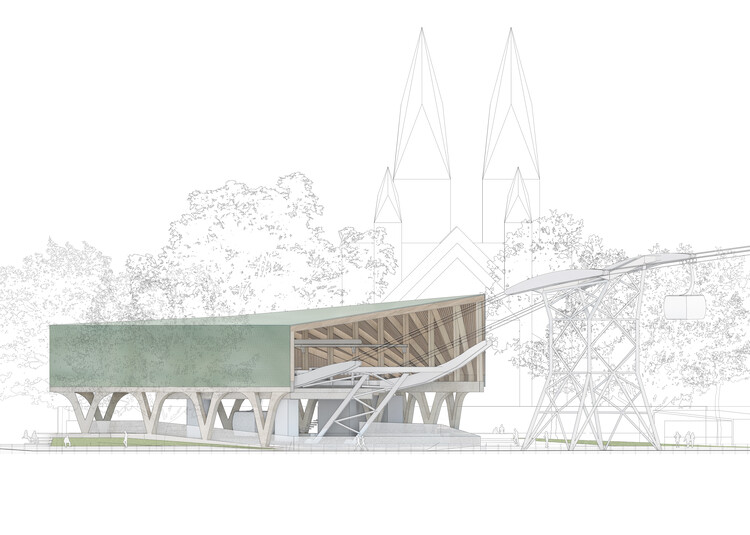 Courtesy of Snøhetta
Courtesy of SnøhettaSnøhetta has won an international competition for the design of the new stations for the city cable car in Koblenz, Germany. Given that the location is within the UNESCO World Heritage Site of the Upper Middle Rhine Valley, the project necessitates a sensitive and respectful approach to the historical context. The proposed stations are designed as contemporary architectural statements that harmonize with the existing heritage, blending into their surroundings.
The cable car, which has been operating since 2011, connects Koblenz’s city center with the Ehrenbreitstein Fortress across the Rhine River. Initially intended to be a temporary structure for the Federal Horticultural Show, the popular and eco-friendly mode of transport has since transitioned into a permanent fixture. Due to the site’s historical significance and the technical requirements involved, a redesign of the cable car stations has become essential. Snøhetta’s proposal, characterized by sculptural forms, won the architectural competition organized by the cable car operator, presenting a cohesive pair of valley and mountain stations.
The valley station, situated near the protected Basilica of St. Castor, features a gently curved design that pays homage to the historic church while reinterpreting the architectural heritage of the city. The jury praised the design for its ability to maintain architectural significance without overwhelming the World Heritage Site. The elegant roof shape serves as a contemporary reference to the Basilica, as a dialogue between old and new.
In terms of structure, the valley station comprises a metal roof supported by a wooden framework on V-shaped concrete columns. The metal shingles are inspired by traditional façades and roof motifs of Koblenz, while the sculpted concrete columns echo the vaulted stonework of the church and local masonry. The subtle green tones and the glossy metal are a nod to the scenic beauty of the Rhine. Similarly, the mountain station features a shared chamfered metal roof to cover its technical facilities, with slender columns linking the design to the Ehrenbreitstein Fortress. A canopy extending over the station integrates an existing tree, providing a sheltered waiting area, while the overall design maintains a clear horizontal alignment with the historic landscape surrounding the fortress.
The cultural landscape and identity of the Upper Middle Rhine Valley are characterized by centuries of human intervention. The new stations are part of this natural and cultural context and with our design, we continue the dialogue with the significant cultural landscape of Koblen. – Patrick Lüth, Snøhetta Partner and Managing Director of the Innsbruck studio
On a similar note, Snøhetta has recently revealed the design for the Omaha Children’s Museum, an age-inclusive cultural facility in the United States. The internationally-recognized office has also recently completed two significant projects, the extension to the Joslyn Art Museum, also in Omaha, United States, and a unique project for the Čoarvemátta Cultural and Educational Hub, completed in collaboration with 70°N architecture and artist Joar Nango.





 Courtesy of Snøhetta
Courtesy of Snøhetta Courtesy of Snøhetta
Courtesy of Snøhetta Courtesy of Snøhetta
Courtesy of Snøhetta